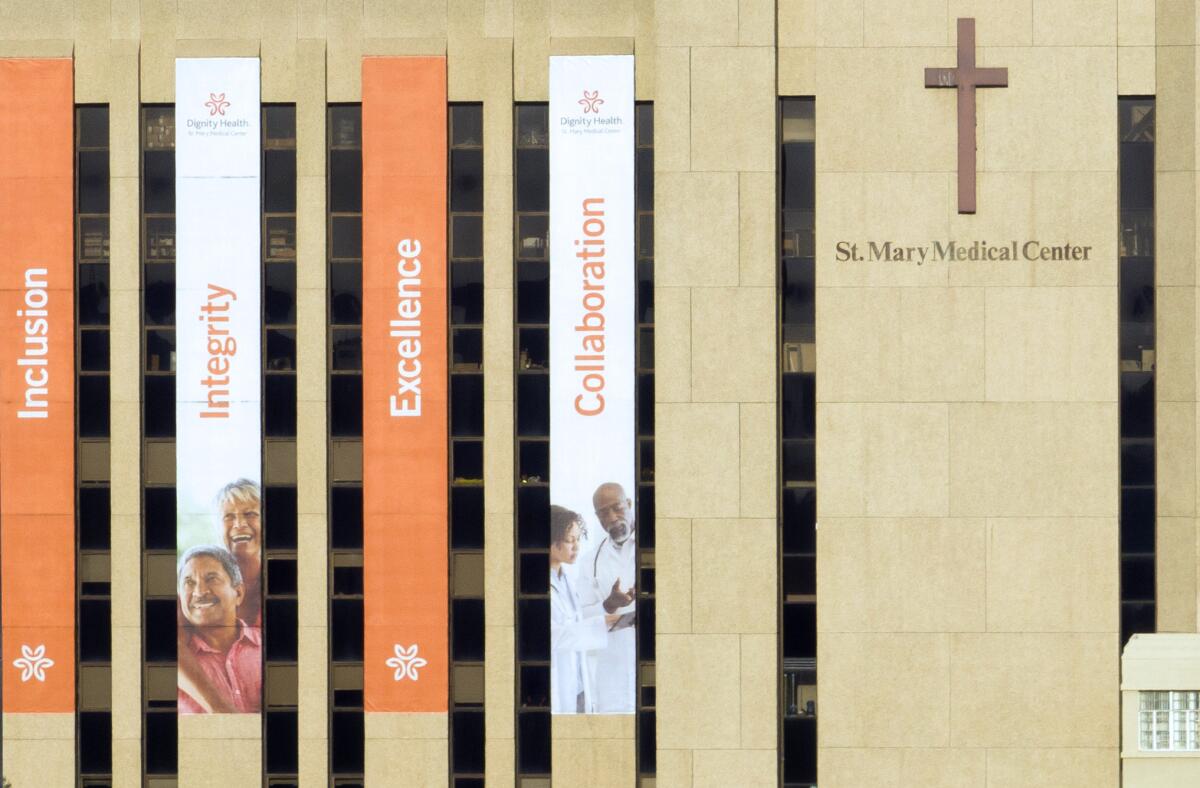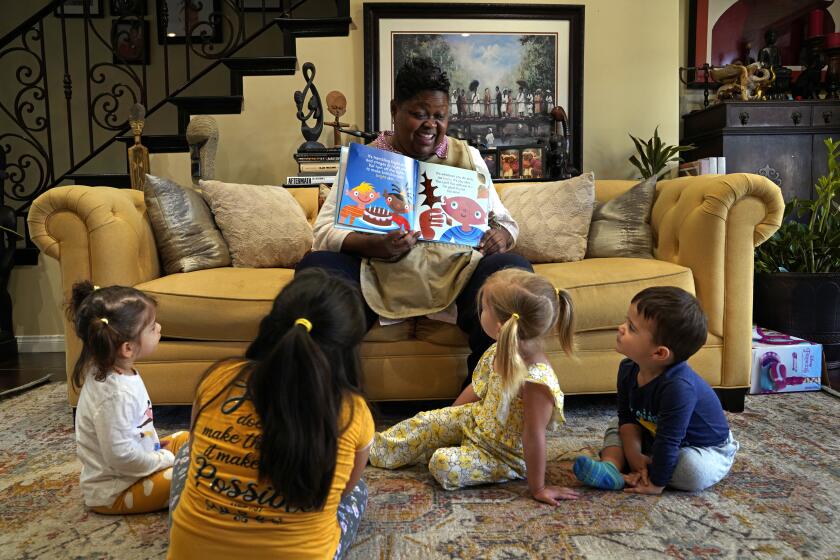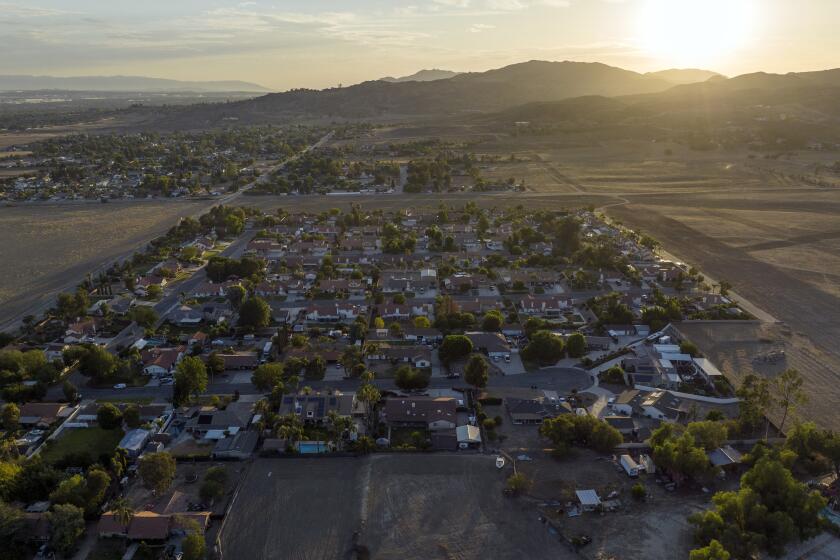Former official says Long Beach hospital ‘dismissed’ plea for barrier to prevent deaths

- Share via
To prevent future deaths, Nancy Valla said, she pressed the Long Beach hospital where she worked to install barriers or fencing at a tall structure on its campus.
A woman had died by suicide there in 2019 — and she was not the first to do so. Researchers say installing barriers can help prevent such deaths by stopping people from acting on a fleeting urge.
But Valla said she was told a barrier would be too expensive and lead to questions that would make the hospital “look guilty,” according to a lawsuit.
The former chief nursing executive officer, who is now suing St. Mary Medical Center for retaliation, wrongful termination and other alleged wrongdoing, said she ultimately went out on medical leave, facing depression and post-traumatic stress disorder, after hospital leaders and their actions exacerbated her distress.
St. Mary, which is part of the Dignity Health system under CommonSpirit Health, has denied her allegations in court filings. Its chief operating officer said they decided not to install a barrier “because it would still not guarantee safety from an intentional attempt of self-inflicted harm.”
Other structures of the same kind in Long Beach did not have such enclosures, a hospital staffer had noted. But across the country and the globe, fencing and barricades have been installed at tall structures such as bridges and parking garages to prevent such deaths, sometimes after mounting pressure from the public.
The University of Iowa installed barriers on parking ramps after a string of suicides. Columbia, Mo., installed fencing and steel mesh barriers after an outcry over deaths at a garage. When workers began putting in the barriers, people stopped on the street to thank them, a supervisor told the Columbia Daily Tribune.
Suicide prevention and crisis counseling resources
If you or someone you know is struggling with suicidal thoughts, seek help from a professional and call 9-8-8. The United States’ first nationwide three-digit mental health crisis hotline 988 will connect callers with trained mental health counselors. Text “HOME” to 741741 in the U.S. and Canada to reach the Crisis Text Line.
In Pennsylvania, the Lancaster Parking Authority put in fencing at a garage where four suicides had occurred in less than a year. The fourth happened after the parking authority had decided against installing a barrier, saying mental health professionals had advised them it wouldn’t work, according to LancasterOnline.
In Switzerland, installing guard rails in the windows of a high-rise hospital significantly reduced deaths, even though “most people could climb over this rail with relative ease.” And perhaps the most famous example is the Golden Gate Bridge, where a safety net is being installed to prevent deaths at the San Francisco landmark.
Valla, in her lawsuit, alleged that the hospital had been “encouraged to create a mechanism to deter future suicide attempts” after an earlier death in 2013. That death, which involved a male patient at St. Mary, also led to a $50,000 fine from the California Department of Public Health for failing to properly assess the man at the emergency department and take precautions to prevent his suicide.
The woman who died in 2019 was not a patient at St. Mary, and the Long Beach hospital has not faced any state citations or fines over her death. But Valla was haunted by what had happened.
“I was the only one that kept saying, ‘OK, what are we going to do? ... We’ve got this problem. We’re in a vulnerable community,’” Valla said. “I kept saying, ‘Let’s put up a barrier.’ I even offered to pay for it myself.”
A list of crisis hotlines, low-fee and sliding scale counseling, support groups, and mindfulness and meditation services
Hospital spokesperson Christina Zicklin said that St. Mary “took no termination action” against Valla, who had not returned to the hospital after going on leave. She said the hospital was never told to construct barriers by the city or any other agency when the incidents happened in 2013 and 2019.
Zicklin also said St. Mary had reported both incidents to the California Department of Public Health, which found no deficiencies involving the structure and did not “make any recommendations for improvement.” And she added that the structure adhered to city codes.
“Patient and visitor safety is always our highest priority,” she said in a statement.
Obstacles can be crucial in preventing people from making fatal decisions, researchers have found. In one “unfortunate natural experiment,” suicides spiked after safety barriers were removed from a bridge in New Zealand, then stopped after barriers were reinstalled, researchers in Christchurch found.
Making it harder for people to act on a suicidal impulse is especially important because that impulse may be quick to evaporate, experts said. Most people who survive one suicide attempt do not ultimately die of a later suicide, studies have found.
“The idea is if you can get somebody through one of those crises, they will have the opportunity to work on getting better,” said Jill Harkavy-Friedman, senior vice president of research for the American Foundation for Suicide Prevention. Such a delay can also buy more time for someone to intervene, she said.
One man’s death may not have been preventable, but understanding what led to it offers hope for others.
Studies found no increases in jumping deaths at nearby sites after barriers were put in place at bridges in Washington, D.C., and Augusta, Maine. When a barrier was built along a Toronto viaduct, deaths initially rose at nearby bridges, but a longer-term study found that “the barrier appears to have had its intended impact” in preventing suicide, with “no statistically significant rise in deaths by jumping from other bridges in the city.”
Harkavy-Friedman said people in such a crisis often have “tunnel vision” that impairs their ability to think flexibly. “If you thwart” what they were going to do, she said, “they don’t often have the capacity to shift gears.”
When it comes to installing such barriers, “I don’t think there’s any good reason for not doing it,” she said, “except that people don’t really understand how effective it can be.”
Psychiatric Nurse Practitioner Shirley Zhen, who examined suicide prevention at a parking garage in Connecticut as a graduate student, argued that it should become the new standard for tall buildings to have physical barriers or other prevention measures in place. But money has often been an obstacle, she said.
People think, “Why would we spend X amount of money on something that might happen only once?” Zhen said.
What if we were given the skills and confidence to turn toward those in crisis?
Dignity Health did not address questions about whether it had analyzed the costs of installing a barrier at the St. Mary site.
In her lawsuit, Valla said her push for St. Mary to put one in place was “dismissed and disregarded” and that the chief operating officer at the time had laughed at her.
When she voiced concerns about whether the St. Mary emergency department could have saved the woman, Valla said, Chief Executive Carolyn Caldwell compared the woman to a dog that had been hit by a car. “That is not the way you talk about a live person,” Valla said in an interview. “I was in shock.”
In a legal declaration, Caldwell said she had been attempting to comfort Valla by sharing a childhood experience of a car hitting her dog.
“While he laid in the street and was still moving, my father told me he could not be saved,” Caldwell said in a court filing. “It was traumatizing for me, but with time, I accepted what had happened. I thought that might help her move past the initial impact of this tragic event.”
Attorneys for St. Mary Medical Center also retained a trauma surgeon to review records about the incident, who concluded that even if the woman had been taken to the St. Mary emergency department, she “would not have survived because of the catastrophic injuries she sustained.”
My hope is that by thoughtfully exploring a topic fraught with stigma and misunderstanding, we can all better support our friends and family who experience depression.
Valla is not the first staffer at St. Mary to publicly raise concerns about Caldwell: Medical staff there issued a vote of no confidence in Caldwell four years ago. Two physicians sued her and the hospital earlier this year, alleging that they were retaliated against after expressing concerns about administration decisions.
Dr. Mauricio Heilbron, one of the physicians suing the hospital, said “the administration of the hospital does not seem interested in the input from the medical staff in regards to patient health and public safety.”
Zicklin, the hospital spokesperson, said St. Mary had succeeded in dismissing some of the allegations in the suit. That ruling is now being appealed.
“CommonSpirit Health leadership continues to have every confidence” in Caldwell, Zicklin said, citing recent honors for St. Mary. “We are fortunate to have Ms. Caldwell as CEO and believe she is the right person to lead St. Mary into the future.”
If you or someone you know is struggling with suicidal thoughts, seek help from a professional and call 9-8-8. The United States’ first nationwide three-digit mental health crisis hotline 988 will connect callers with trained mental health counselors. Text “HOME” to 741741 in the U.S. and Canada to reach the Crisis Text Line.
More to Read
Sign up for Essential California
The most important California stories and recommendations in your inbox every morning.
You may occasionally receive promotional content from the Los Angeles Times.


















